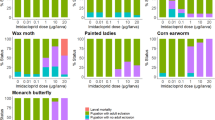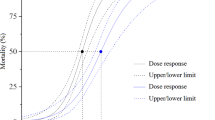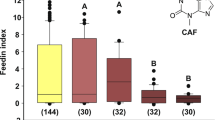Abstract
THE monarch butterfly (Danaus plexippus) is one of the best known species which sequester and store cardiac glycosides1–3 obtained directly from their larval food plants. On the other hand Euploea core, a related Danaid species feeding on the same family, Asclepiadaceae, is a poor storer of these substances4. Cardenolides are absent if the butterflies are reared on plants which do not contain them, and, in the past, all cardioactivity in the insects' body tissues has been attributed to dietary cardenolides. We now report that extracts of both larva and pupa reared on a leaf-free artificial diet5 proved cardioactive, slowing the action of an isolated rat heart (Langendorff preparation)6 and increasing the amplitude of contraction.
This is a preview of subscription content, access via your institution
Access options
Subscribe to this journal
Receive 51 print issues and online access
$199.00 per year
only $3.90 per issue
Buy this article
- Purchase on Springer Link
- Instant access to full article PDF
Prices may be subject to local taxes which are calculated during checkout
Similar content being viewed by others
References
Reichstein, T., von Euw, J., Parsons, J. A. & Rothschild, M. Science 161, 861–866 (1968).
Roeske, C. N., Seiber, J. N., Brower, L. P. & Moffitt, C. M. Recent Adv. Phytochem. 10, 93–167 (1975).
Dixon, C. A., Erickson, J. M., Kellett, D. N. & Rothschild, M. J. zool. 185, 437–467 (1978).
Marsh, N., Clarke, C. A., Rothschild, M. & Kellett, D. N. Nature 268, 726–728 (1977).
David, W. A. L. & Gardiner, B. O. C. Bull. ent. Res. 53, 91–109 (1962).
Langendorff, O. Pflügers Arch. ges. Physiol. 66, 355–400 (1897).
Parsons, J. A. J. Physiol., Lond. 178, 290–304 (1965).
Rothschild, M. & Marsh, N. Entomologia exp. appl. (in the press).
Frazer, J. F. D. & Rothschild, M. Int. Cong. Ent. 3, 249–256 (1961).
Windecker, W. Z. Morph. Ökol. Tiere 35, 84–138 (1939).
Aplin, R. T. & Rothschild, M. in Toxins of Animal and Plant Origin, Vol. 2 (eds de Vries, A. & Kochva, E.) 579–595 (Gordon and Breach, London, 1972).
Pasteels, J. M. & Daloze, D. Science 197, 70–72 (1977).
Rothschild, M. in Insect/Plant Relationships (ed. van Emden, H. F.) 59–83 (Blackwell, Oxford, 1972).
Rothschild, M., von Euw, J., Reichstein, T., Smith, D. A. S. & Pierre, J. Proc. R. Soc. Lond. B 190, 1–31 (1975).
Marsh, N. & Rothschild, M. J. zool. 174, 89–122 (1974).
Author information
Authors and Affiliations
Rights and permissions
About this article
Cite this article
ROTHSCHILD, M., MARSH, N. & GARDINER, B. Cardioactive substances in the monarch butterfly and Euploea core reared on leaf-free artificial diet. Nature 275, 649–650 (1978). https://doi.org/10.1038/275649a0
Received:
Accepted:
Issue Date:
DOI: https://doi.org/10.1038/275649a0
This article is cited by
-
Cardenolide sequestration by the dogbane tiger moth (Cycnia tenera; Arctiidae)
Journal of Chemical Ecology (1983)
Comments
By submitting a comment you agree to abide by our Terms and Community Guidelines. If you find something abusive or that does not comply with our terms or guidelines please flag it as inappropriate.



